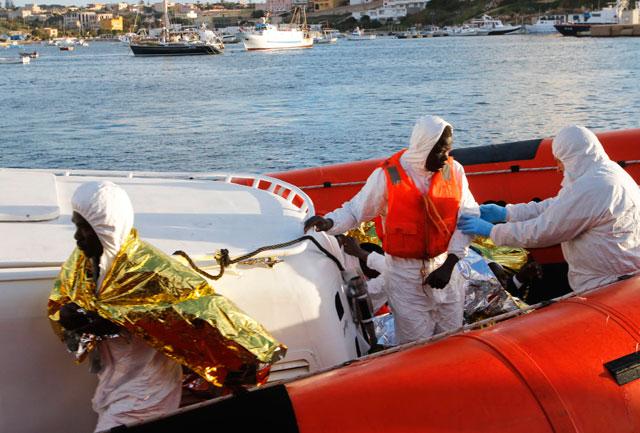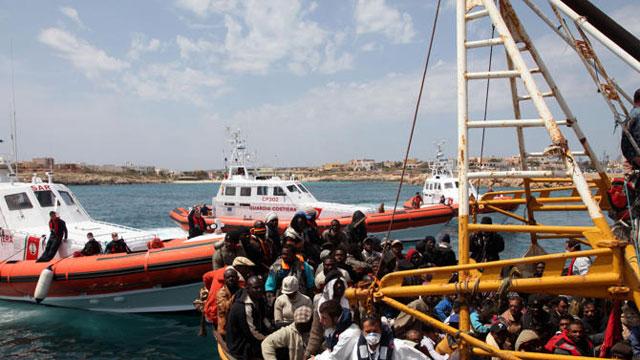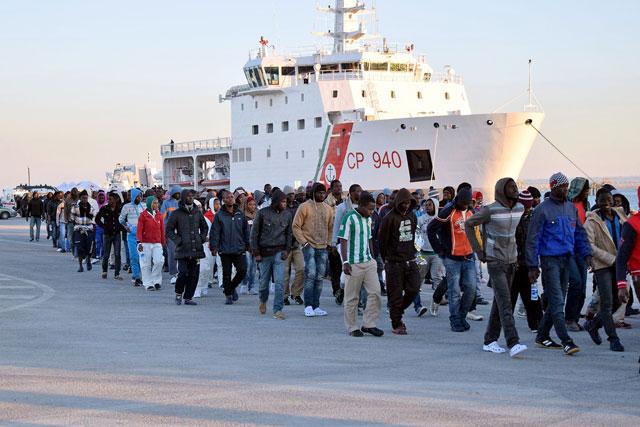You are here
300 feared drowned in new Mediterranean boat tragedy
By AFP - Feb 11,2015 - Last updated at Feb 11,2015

Rome — More than 300 migrants were feared drowned Wednesday after their overcrowded dinghies sank in the Mediterranean, the latest boat disaster on the perilous crossing from Africa to Europe.
The victims were among migrants mainly from sub-Saharan Africa who had left the coast of Libya at the weekend in four small boats, the UN refugee agency said.
"This is a tragedy on an enormous scale and a stark reminder that more lives could be lost if those seeking safety are left at the mercy of the sea," UNHCR Europe Director Vincent Cochetel said in a statement.
Details of the new disaster emerged after nine survivors out of a group of more than 200 packed into two dinghies were rescued by the coastguard and taken to the Italian island of Lampedusa — just days after 29 perished in the same area.
"Nine were saved after four days at sea. The other 203 were swallowed by the waves," UNHCR spokeswoman in Italy, Carlotta Sami, said on Twitter.
The agency later said that reports gathered by UNHCR from the Italian coastguard and the survivors in Lampedusa now suggest some 300 people are confirmed missing.
In the last year alone, several thousand people have died trying to cross from North Africa to Europe across the Mediterranean, on what the United Nations has described as the most dangerous route in the world.
The International Organisation for Migration (IOM) said the surviving migrants from the latest disaster spoke French, so probably came from West Africa.
"Because of the bad weather conditions, the two dinghies collapsed and the people fell at sea. Many drowned," said the IOM spokesman in Italy, Flavio Di Giacomo.
The organisation's spokesman in Geneva Joel Millman told AFP that information was coming in about another stricken boat and warned that the overall toll may reach as many as 350.
Ill-equipped boats
Di Giacomo said the latest victims had left from a beach near Tripoli along with another dinghy also carrying more than 100 migrants plucked from their distressed boat by the Italian coastguard early Monday.
The 29 who were found Saturday had died of exposure in horrific conditions in international waters, in what humanitarian organisations said was an avoidable tragedy.
Their small boat was hopelessly ill-equipped to cope with waves up to 8 metres high, gale-force winds and torrential rain.
But doctors involved in the rescue operation believe more would have survived if they had been rescued by a large military vessel rather than the small patrol boats that were sent to their aid.
The latest deaths have highlighted the limited means and scope of Triton, an EU-run mission which took over in November from the Italian navy's Mare Nostrum search and rescue operation.
Italy decided to scale back the mission after its EU partners refused to share running costs of around 9 million euros ($10 million) a month.
Triton, which comes under the authority of the EU borders agency Frontex, has a monthly budget of 2.9 million euros ($3.3 million) and its patrols are generally restricted to the territorial waters of EU member states.
Humanitarian groups said their warnings about what would happen after Mare Nostrum was suspended had been proven true.
Well over 3,200 people have died in the last year attempting to reach Italy by boat from North Africa.
Over 170,000 people were landed in Italy in 2014 after being picked up by the navy, coastguard or merchant ships.
Most of the migrants are fleeing conflict and repression in the Middle East and East Africa and make their way overland to Libya to board boats operated by people smugglers.
Some smugglers have begun using bigger boats which can withstand winter storms and make longer journeys, notably from Turkey or Syria.
Related Articles
Italian authorities said Saturday that more than 900 people had been rescued at sea in 24 hours, in a blow to hopes that the approach of winter would stem the flow of migrants attempting perilous crossings of the Mediterranean.
Up to 700 people were feared drowned Sunday after an overcrowded boat smuggling them to Europe capsized off Libya in the latest and deadliest in a long list of migrant disasters in the Mediterranean.
Amnesty International accused the EU of putting thousands of migrants at risk Wednesday by scrapping rescue operations in the Mediterranean as Italian coastguards said no more survivors have been found from a shipwreck which may have claimed 400 lives.



















